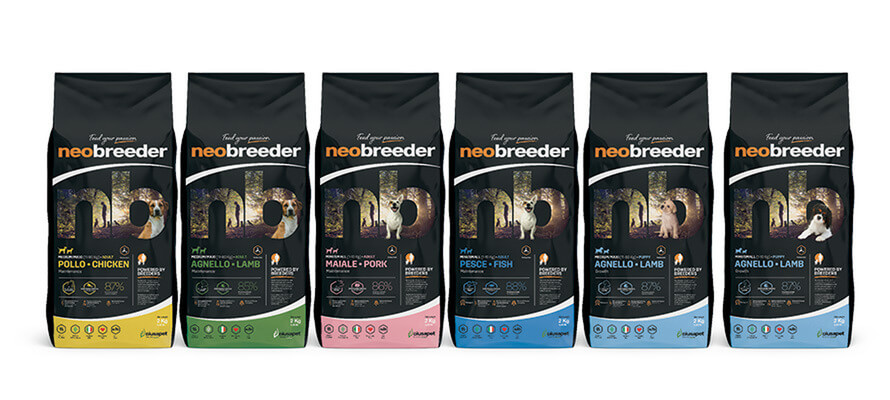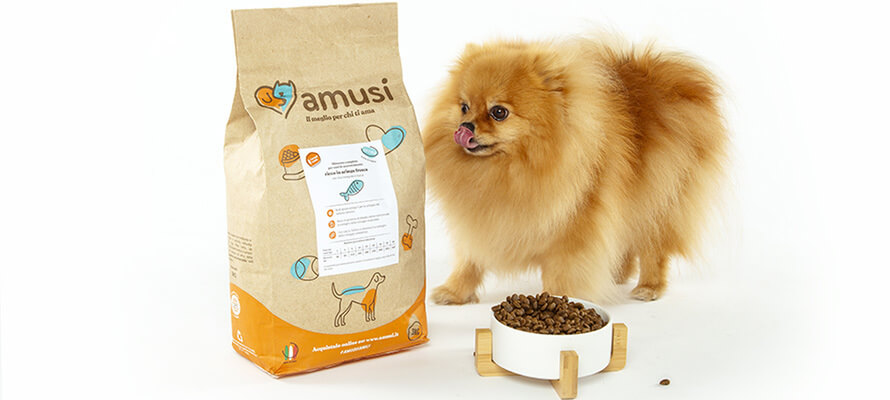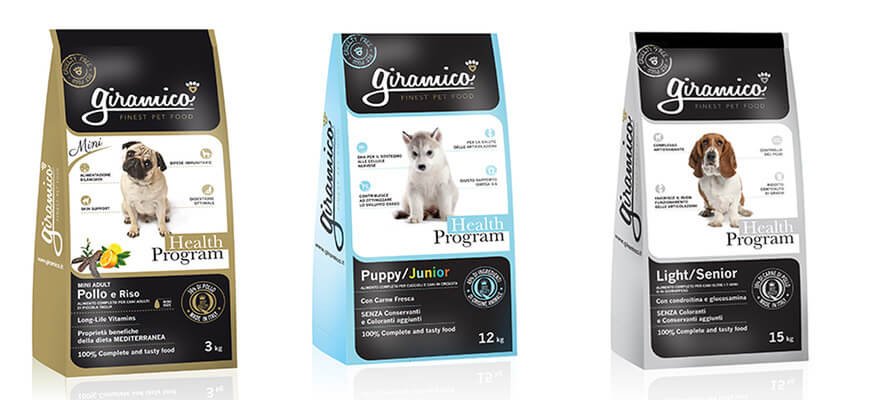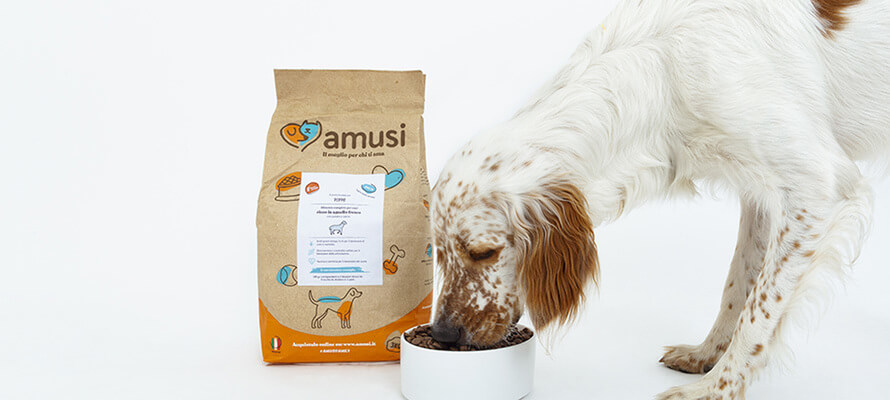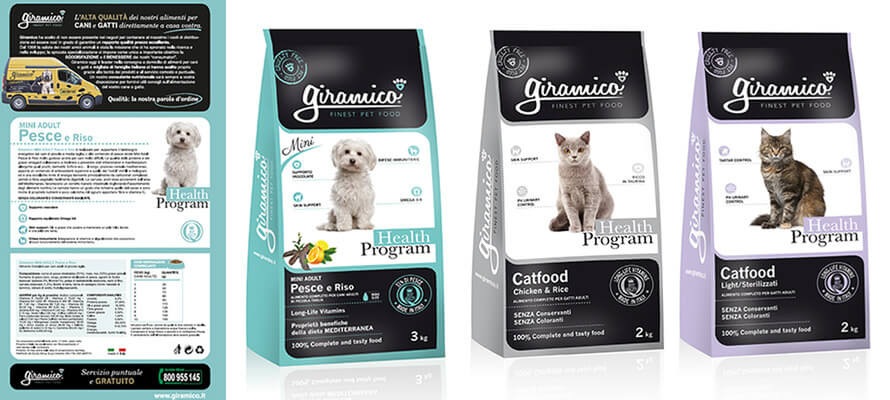A new generation of pet food
What would dogs and cats buy if they had a choice? How do you communicate a product that does not sell to the 'end consumer' but to those who care for them? What are pet food's technical challenges and design trends, and how is packaging changing between physical and digital sales channels? We discussed this with Giulia Di Bartolomeo of White Studio and Raffaele Russo of The Village, studios specialising in brand and packaging design, and Roberta Polettini of Amusi, a newly developed Italian pet food company.
By Roberta Ragona | On PRINTlovers 98
Ten million cats and almost nine million dogs, not to mention fish, birds, small mammals and reptiles: the number of animals living with us is nearly 65 million, according to the latest ASSALCO report (National Association of Enterprises for the Feeding and Care of Companion Animals) presented in May 2023 at Zoomark, one of the most important trade fairs in the sector. A multitude of individuals with needs, preferences, specificities and idiosyncrasies when it comes to food. But unlike - almost - all of us, they are outside the business of buying and preparing food. Feeding all these animals is a market growing steadily in volume and turnover: almost +5% between 2019 and 2020 and over +11% between 2021 and 2022.
But what are a market's technical and communication requirements where the buyer is not the product's consumer? What are the specifics of pet food storage and purchasing patterns?
Functionality and safety first
The first rule could be summarised as functionality leads. Giulia Di Bartolomeo, founder of White Studio, explains: “In the pet food sector, we have four main types of packaging, where the main division is between wet and dry, with their respective needs: in one case to retain moisture while avoiding product degradation, and in the other, to keep moisture out while maintaining nutritional value. For wet food, preference is given to cans and single-dose trays, in printed aluminium or with a label and secondary packaging in paper or cardboard, to which flexible single-dose sachets with zips have been added in recent years. For dry food, on the other hand, the packaging is designed to safely store large quantities of food, with 5, 15 and 20-kilo bags for which films of poly-laminated material are mainly used.”
“In both cases,” continues Di Bartolomeo, “the technical requirements are the driving force: they must meet MOCA (Materials and Objects in Contact with Food) requirements, there is a need for extremely reliable technology that can guarantee a very long shelf life without loss of product quality. This means materials that protect against UV radiation and significant changes in temperature and humidity during transport, storage and sale. From the point of view of printing technologies, on the other hand, it is the sales channels that make people opt to use enhancements, foils and texture effects. The reasoning is on how it will be perceived among its competitors.”
“For a brand whose main channel of contact with the consumer is the large-scale retail trade, it becomes necessary to deploy all the tools of packaging design to ensure that its product is easily spotted in a crowded sector: so we have UV coatings, glossy/mat contrasts, gold/silver film or material effects that also take into account the physical feel of the packaging when the consumer picks up the different packs to compare their characteristics and qualities. For those using a direct distribution model or through online channels, the consumer arrives at the brand already armed with information and does not need to locate it on the shelf. This also allows them to make different choices by opting for more graphic and communication research, which is effective without the additional costs of refinements at the printing stage.”
A customised offering
The direct experience of Roberta Polettini, Brand and Business Manager of Amusi, confirms these observations. This new concept pet food start-up puts customised nutrition and Made in Italy at the centre of its offering: “We opted for fully recyclable packaging in a paper/plastic laminate with a greaseproof finish and plastic film that acts as an oxygen barrier. We relied on research on the experiences of foreign players who have been making this choice for some time and who have the data to confirm the reliability of the material for the preservation of a product with a large fat component and a shelf life of up to 18 months. By having a subscription product that goes directly to the consumer, we were able to work differently, avoiding the plastic/aluminium poly-bag that is disposed of in different ways from municipality to municipality – which means not guaranteeing recyclability for all consumers regardless of where they are. At the same time, we worked on secondary packaging, with shipping boxes designed to withstand the rigours of courier shipments. From a visual point of view,” Polettini continues, “the Amusi communication breaks away from a certain type of very 'muscular' pet food communication. We wanted to create a sense of belonging to an online community of people united by a common feeling concerning their relationship with their animals, starting from the copywriting to the coordinated image, which prefers warm tones and soft colour combinations.”
Conveying information
From the point of view of consumer information, the trends follow what is happening in food, which is why the experience of agencies in food packaging is an essential source of expertise and inspiration, as Raffaele Russo, co-founder of The Village, confirms: "Most products at the moment fall under the definition of the 'rich in' phenomenon or what in the food sector for people are enrichments with so-called 'superfoods’. Products that are united by the presence of functional ingredients or enriched with key nutrients, such as prebiotics, vitamins, fibre or Omega 3. Similarly, just as in human nutrition, we are witnessing an expansion of 'free from' or 'zero' products, likewise in pet food: from 'gluten-free', 'palm oil-free’ to 'preservative-free', there is a growing offering for those sensitive to food intolerances, or with single-protein protein sources or lower salt content. On the one hand, functional reasons, on the other hand, a reflection of the health consciousness of food that reverberates on pet food.”
The findings of Osservatorio Immagino also confirm this opinion. This six-monthly study cross-references NielsenIQ data on sales in the large-scale retail trade with the conclusions from Immagino, the digital brand content management web service of GS1 Italy Servizi, which has digitised and analysed product images and information on labels, enabling the aggregate analysis of more than 4,700 pet food products in the large-scale retail trade and the information on the label, from the nutritional table to the description, including certifications, allergens, packaging materials and the transfer of packaging at the end of the product's life.
The passage of information to the consumer also impacts the design work, as in the case of the packaging developed by Giulia Di Bartolomeo for Giramico: "The company contacted me to develop product lines that would enhance their experience in terms of research and selection of suppliers of quality raw materials. I paid particular attention to the infographic system for the packaging, in which to combine clear information about the specificities of the individual lines with an icon system that was consistent with the corporate image and also had its own aesthetic appeal. The products need a strong communication differentiation because one of the driving factors in pet food sales is the consumer's perception that the product is specifically tailored to their pet's needs. We started with the main line, Health Program, and from there, we worked on the logo, the corporate image and all the specific lines. As we specialise in food photography, we worked on enhancing the quality of the raw materials with a design with impactful photos and simple graphics at its centre."
The new quality influencers
Guaranteeing consumers the quality of what they are buying are the experts, as in the case of The Village's work on the Alleva and Neobreeder brands: "We had the opportunity to work for four years for Diusapet, a multinational pet food company, first on the Alleva brand, and then on the Neobreeder project under the leadership of Head of Marketing, Paolo Santini.”
“The classic packaging of specialised pet food from pet shops is the legacy of a communication era in which veterinarians recommended functional pet food, so even the packaging tended to emulate the institutional seriousness of a product with an almost clinical value. Nowadays, the key experts, especially for purebred dogs, are breeders. They are the first line in the purchasing process, advising the owner on how to feed their animal in a balanced manner. All the communication and image work done around Neobreeder revolves around this concept: the first line of dog food tested and recommended by breeders, who have also become the spokespersons for the B2B campaign.”
Sustainability and loyalty
But what are the market trends in the near future? As always, in first place is the increased sustainability of packaging. The in-depth study by Osservatorio Immagino shows that the interest in sustainability is reflected both on the supply side, which offers almost 140 products with biodegradable or recyclable packaging, and on the demand side, which is expressed by growth in turnover and volumes.
Di Bartolomeo emphasises that channel diversification will also be a vehicle for change: "A key factor is the distribution channel, both from the point of view of consumer expectations and the type of stress the packaging is subjected to in the warehouse and on the shelf. A more discerning consumer will prefer a shorter supply chain, allowing for easier packaging to dispose of because the product's shelf life and storage time inside it is different. At the same time, a large-scale retailer will expect to find a range of products from first price to premium, which should therefore have longer shelf lives, be easier to store for longer periods and often in larger quantities.”
According to Raffaele Russo, the discriminating factor for manufacturers is often cost: “For dry goods, research is focusing on single-material, especially working on lowering production costs. If on-paper and aluminium disposal is straightforward, the real challenge is the bags. The disposal chain for poly-bags is very uneven in different parts of Italy. In the more distant future, the next step will surely be biofilm - plastics from plant sources and bioplastics; plus, there’ll be packaging designed for online purchase, reuse and refill, even with subscription formulas in which containers for long-term storage are bought once and then refilled with the product shipped in barrier paper packaging, which must protect the product for a shorter time than shelf logistics.”
A target group of consumers that in the case of Amusi is already the core: “Our main customers are people between 35 and 55 years of age, who live in urban centres and for whom online shopping is part of the usual shopping landscape. They are well-informed and accustomed to purchasing the services that best suit their needs through subscription formulas and are not necessarily available in physical outlets. They are also consumers willing to spend more if they receive quality and services in return. Subscription is a form of loyalty built on the customer experience, which takes one thought away from the buyer because they know they will receive the right amount of food directly at home for the period calibrated to their pet's needs. The frontier at the moment is the expansion to non-food products. We have noticed that once the food product convinces consumers, they are more than willing to extend the same trust to hygiene and wellness products because they trust that they will be made with the same underlying values.”
